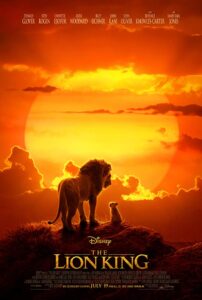Photorealistic parody fails to find a creative and narrative purpose.


It’s time to recognize the true reason for Disney’s remake trend: greenbacks! Of course, this should come as no surprise. Walt Disney Pictures is a massive commercial enterprise, after all. And business has been good with the immense success of the Marvel Cinematic Universe, continued hits through its ground-breaking animation powerhouse Pixar, and the successful acquisition of Star Wars. But even though the coffers are overflowing, Disney executives decide to recycle instead of innovate.
And the latest remake takes one of their most revered hand-drawn animated properties and puts a realistic gloss on top it. Call it Disney Nature becomes Disney Narrative, as “African Cats” morph convincingly into “The Lion King.” But the more and more real things look, the more my mind kept thinking about the real circle of life—lions eat most everything, right?

Covering essentially the exact same ground as its venerable 1994 predecessor, this version even features some of the same voice talent, most notably that of the iconic James Earl Jones as Mufasa, the ill-fated leader of the pride. Donald Glover takes over voice duties from Matthew Broderick as the grown Simba, and Beyoncé voices Nala, stepping into the role previously held by Moira Kelly. While the names are note-worthy, nothing about these vocal changes adds much to the distinct personality of the characters.
In fact, the film hardly makes any unique mark at all until the appearance of Timon and Pumbaa voiced by Billy Eichner and Seth Rogen. It’s hard to improve on what Nathan Lane did with Timon in the original, but Eichner and Rogen have a really “dude-bro” thing going here. The “Lion King” needed more of that modernization. The splashy effects alone just aren’t enough.

Jon Favreau, who gave us 2016’s wonderful “The Jungle Book,” directs what amounts to a photorealistic “Lion King” parody. Prior to the screening, we were cautioned not to refer to this remake as a live-action film. The idea is that it is all animated, although the effect is to make absolutely everything appear real, with weight and authentic texture. Therefore, when the animals speak, their mouths do not move like human mouths.
For example, Zazu (voiced here by John Oliver), a red-billed hornbill, moves his beak when the words come out, but the beak remains rigid just like a real bird. In the 1994 hand-drawn version, the beak moved differently around the words as they were formed. In the 2019 update, it will take some getting used to this new approach.

The ultimate success of this version both critically and at the box office will help guide Disney moving forward. Where the comedy of “Aladdin (2019)” was innocuous, and “Dumbo (2019)” tried to inject new story elements within the same general narrative parameters, this version of “The Lion King” does little to distinguish itself. Purists will overwhelmingly prefer the original. The remakes of “Aladdin” and even “Dumbo” before it, featured human characters interacting with fantastic animal counterparts. But “The Lion King” is all animals, that look entirely realistic, but exist in a society that is completely unrealistic.

What might work with the liberties of hand-drawn animated techniques aren’t directly available in the new photorealistic arena. Just because the animation can achieve the illusion of life perfectly, doesn’t mean that it is the right format for all story-telling. “The Lion King” works best with the whimsical animation that first brought it to the screen.
Sadly, there will be a generation of children that may be first introduced to “The Lion King” with this new version, as families eschew older-style animated fare. And Disney in remaking its past might cause many for forget its storied history.
